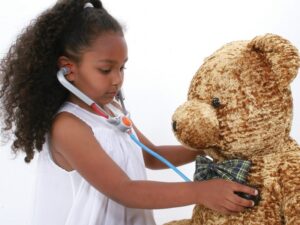
Keeping Your Child Healthy
“Grace went from being tired to having tummy aches and headaches, and I knew she was not getting enough sleep at night,” says Beverly Hoffmann of her eight-year old daughter. “She seemed to have lost the gusto she had just last summer.” Determined to find answers, Beverly brought Grace to the pediatrician. The pediatrician told her that physically, nothing was wrong, and that Grace was in great shape. Feeling defeated, Beverly still felt that something was going on with her child so she started taking a closer look at Grace’s overall lifestyle and found some surprising answers.
Every parent worries about whether they are doing the right thing when it comes to making decisions about their children and keeping them healthy. As parents, we have to work hard to instill healthy habits in our children so they can go on to live healthy lives, and teach their children to do the same.
It’s important to keep up with regular well child visits, stay current on vaccinations and create healthy habits like hand washing and good dental care, but it takes more than just an apple a day to keep the doctor away and to keep your child healthy.
To get a feel for where your kid falls on the health and wellness spectrum, your pediatrician is the key component. For instance, taking a look at their physical health, activity level, diet, environment, sleep habits, and emotional and behavioral health is crucial.
Physical Health
Louisiana seems to be winning the wrong kind of race–the one to obesity. According to a report by Pennington Biomedical Research Center, approximately 1 in 3 Louisiana children are overweight or obese. Louisiana has consistently received a grade of “F” for childhood overweight and obesity.
The Raising FIT Kids BMI Calculator on WebMD will compute your child’s body mass index (BMI) to determine if your child’s BMI falls into an underweight, healthy weight, overweight, or obese range. And, more importantly, you’ll better understand how your child’s weight and body fat contribute to his current and future health.
Activity
Pennington Biomedical Research Center recommends that children engage in moderate physical activity at least three times a week for 30 minutes or more and in vigorous physical activity at least twice a week for 20 minutes or more.
Getting outside is key. Many of the developmental tasks that children must achieve including exploring, risk-taking, and fine and gross motor development can be effectively learned through outdoor play. On the bright side, being outside also exposes your child to sunlight, the best source of Vitamin D, needed for healthy bone and cell growth.
Diet and Nutrition
As your child grows, their nutritional needs will also begin to grow. Children can be picky at all ages so making sure they are getting all of their vegetables seems to be a universal challenge. However, there are some things parents can do from the start that make it easier to develop good eating habits.
Cut out junk food. Junk foods are appealing, readily available, and cheaper compared to snacks with lower fat, sodium, and sugar. Soda and junk foods have been linked to higher risks of obesity, diabetes, heart disease, and lower intake of important nutrients.
Stock your house with healthier choices. These could include peanuts, trail mix, pretzels, organic crackers, or Pirate Booty available in bulk from Costco. Add fruit and vegetables to the mix as well as yogurt, cheese sticks, turkey sticks and beef jerky.
Environment
The environment can have important physical and psychological effects on children. It’s easy to overlook pesticides, ozone levels, lawn maintenance, paint on toys, mercury in fish, play equipment, and plastic drink bottles. Exposure to tobacco and mold are harmful for children. Flooded homes or leaky roofs can expose your child to mold growth, resulting in allergies and asthma.
Children’s metabolic rate is higher than adults, and they consume more oxygen and produce more carbon dioxide that causes more air pollution for their body mass. Open your windows because ventilation is needed to keep CO2 levels down.
Installing carbon monoxide detectors can help to prevent unintentional CO poisoning, the most common cause of poisoning especially in winter months where heat is used in the house. In 2010, there were 1,696,746 potential unintentional CO poisoning emergency room visits in Louisiana.
Screen Time
Technology is abundant. Time spent with gadgets, and various screens should be limited. This includes any kind of screen, whether it is television, video games, computers, tablets, or phones.
The AAP recommends keeping all screens out of children’s bedrooms, especially at night. It’s a good idea to turn off all blue-light emitting screens at least 30 minutes before your child’s bedtime. The newest guidelines, from the American Academy of Pediatrics (AAP) states that you should not introduce screen time until age two.
Sleep Habits
According to the National Science Foundation, kids who don’t get enough sleep are less able to concentrate or perform complex tasks. The lack of vitamin “zzz” can cause your child to be sick, depressed, and obese.
Children don’t necessarily slow down the way we do when they are tired. Instead, they wind up and have more energy. In fact, sleepiness can look like symptoms of attention deficit-hyperactivity disorder (ADHD). AAP has a simple and clear message for parents: Brush, Book, Bed. Establish a clear and consistent routine to aid bedtime woes.
Although each child is different, after six months of age, afternoon naps of one and a half to two hours duration are expected and naps generally discontinue between ages two to five years. Research shows that an early bedtime, between 7-8 p.m., works best for babies and kids through school age and they need 10-11 hours of sleep a night.
Researchers and clinicians are also finding that sleep apnea–which most people tend to think of as an adult sleep disorder–is relatively common in children as well.
Emotional Health
Experts say that providing children with a positive environment with love, compassion, trust, and understanding are important for them to build a productive lifestyle. As parents, we have to show them what love looks like. Children who are not exposed to this kind of environment have a difficult time dealing with their emotions.
Another important piece is teaching your children that they will not always get their way. They must get used to hearing the word “no.” Learning to overcome obstacles, resolving conflict, and problem solving skills are vital to their existence as healthy adults. Every child must learn how to handle disappointment, delayed gratification, and things not going their way, and knowing that their family will be there to support them when they face disappointment.
Beverly discovered that her daughter’s health was affected by the environment around her as she was suffering from allergies. The family made some simple changes to Grace’s room by changing her pillow to a non-allergic brand and eliminating most of her stuffed animals throughout her bedroom. Maddie, the family cat, proved to be the biggest allergy trigger for Grace and removing her from Grace’s room was needed. Grace continues to see local allergists with hopes of having her beloved pet back in her room. ■





